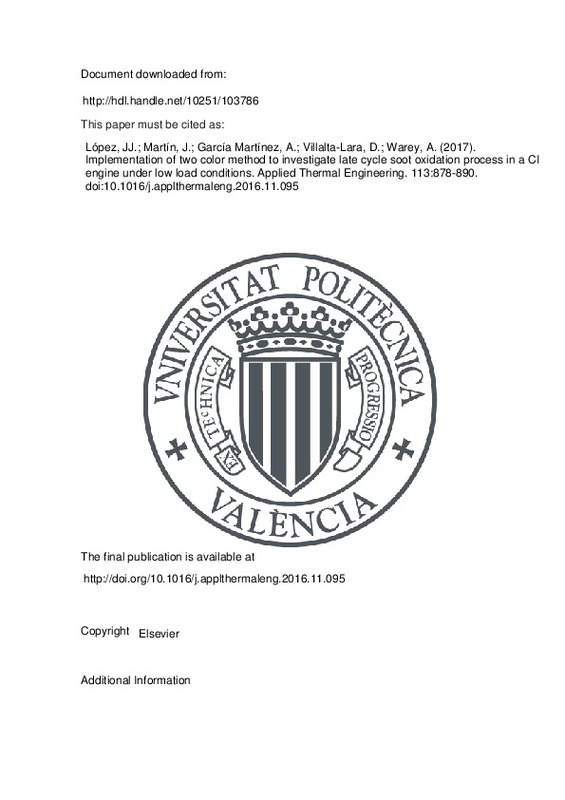JavaScript is disabled for your browser. Some features of this site may not work without it.
Buscar en RiuNet
Listar
Mi cuenta
Estadísticas
Ayuda RiuNet
Admin. UPV
Implementation of two color method to investigate late cycle soot oxidation process in a CI engine under low load conditions
Mostrar el registro sencillo del ítem
Ficheros en el ítem
| dc.contributor.author | López, J. Javier
|
es_ES |
| dc.contributor.author | Martín, J.
|
es_ES |
| dc.contributor.author | García Martínez, Antonio
|
es_ES |
| dc.contributor.author | Villalta-Lara, David
|
es_ES |
| dc.contributor.author | Warey, Alok
|
es_ES |
| dc.date.accessioned | 2018-06-11T04:29:49Z | |
| dc.date.available | 2018-06-11T04:29:49Z | |
| dc.date.issued | 2017 | es_ES |
| dc.identifier.issn | 1359-4311 | es_ES |
| dc.identifier.uri | http://hdl.handle.net/10251/103786 | |
| dc.description.abstract | [EN] Soot emissions from diesel engines are an important concern in meeting emissions regulations. Soot emissions are the result of two competing processes: soot formation and soot oxidation. Mechanisms of soot formation are discussed extensively in the literature. Equivalence ratio at lift-off length along with residence time and gas temperature play an important role for soot formation in a diffusion flame. Mixing capability and bulk gas temperature are the most important parameters that influence the in-cylinder soot oxidation process. Normally, research studies of soot formation-oxidation processes have been developed under controlled and not completely representative conditions of engine operation in the field. Therefore, the main objective of this work was to develop a simplified methodology to evaluate in cylinder soot oxidation under 'real' engine conditions. In particular the impact of mixing process and bulk gas temperature on late cycle soot oxidation was evaluated. The experimental measurements were made in a production light-duty diesel engine varying those parameters that have been demonstrated in the literature as the most relevant in soot formation - oxidation processes; injection pressure, ambient density and intake air temperature. To measure soot, two color method was applied by means of an optoelectronic pyrometer. To evaluate the mixing capability a specific "tracer" Apparent Combustion Time (ACT(-1)) based on the experimental heat release and injection parameters was defined. The relationship between both parameters was used to explain the soot oxidation process. (C) 2016 Elsevier Ltd. All rights reserved. | es_ES |
| dc.description.sponsorship | The authors acknowledge General Motors Global Research & Development for supporting this research. | |
| dc.language | Inglés | es_ES |
| dc.publisher | Elsevier | es_ES |
| dc.relation.ispartof | Applied Thermal Engineering | es_ES |
| dc.rights | Reconocimiento - No comercial - Sin obra derivada (by-nc-nd) | es_ES |
| dc.subject | Multi-cylinder pyrometer | es_ES |
| dc.subject | Soot oxidation | es_ES |
| dc.subject | Two color method | es_ES |
| dc.subject | Optical thickness | es_ES |
| dc.subject | Mixing capability | es_ES |
| dc.subject.classification | MAQUINAS Y MOTORES TERMICOS | es_ES |
| dc.title | Implementation of two color method to investigate late cycle soot oxidation process in a CI engine under low load conditions | es_ES |
| dc.type | Artículo | es_ES |
| dc.identifier.doi | 10.1016/j.applthermaleng.2016.11.095 | es_ES |
| dc.rights.accessRights | Abierto | es_ES |
| dc.date.embargoEndDate | 2019-02-25 | es_ES |
| dc.contributor.affiliation | Universitat Politècnica de València. Departamento de Máquinas y Motores Térmicos - Departament de Màquines i Motors Tèrmics | es_ES |
| dc.description.bibliographicCitation | López, JJ.; Martín, J.; García Martínez, A.; Villalta-Lara, D.; Warey, A. (2017). Implementation of two color method to investigate late cycle soot oxidation process in a CI engine under low load conditions. Applied Thermal Engineering. 113:878-890. doi:10.1016/j.applthermaleng.2016.11.095 | es_ES |
| dc.description.accrualMethod | S | es_ES |
| dc.relation.publisherversion | http://doi.org/10.1016/j.applthermaleng.2016.11.095 | es_ES |
| dc.description.upvformatpinicio | 878 | es_ES |
| dc.description.upvformatpfin | 890 | es_ES |
| dc.type.version | info:eu-repo/semantics/publishedVersion | es_ES |
| dc.description.volume | 113 | es_ES |
| dc.relation.pasarela | S\321434 | es_ES |







![[Cerrado]](/themes/UPV/images/candado.png)

